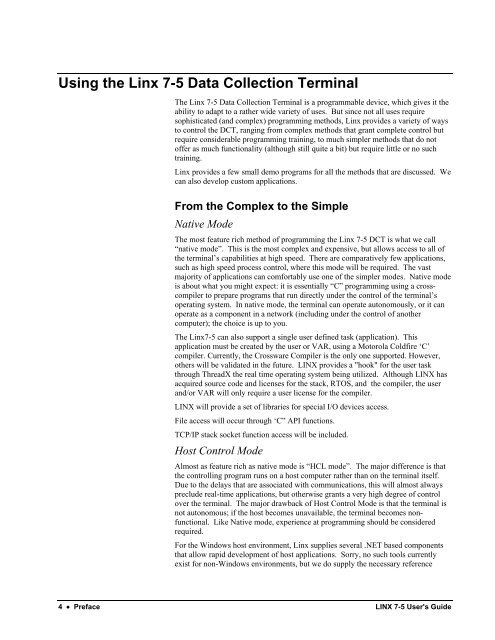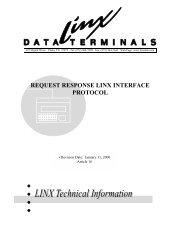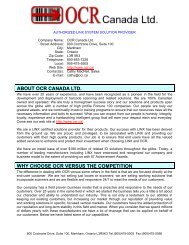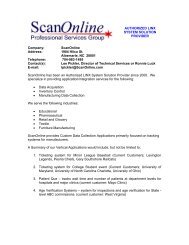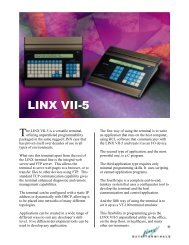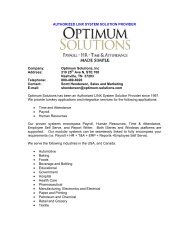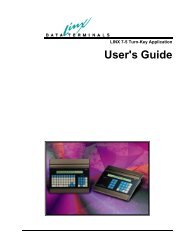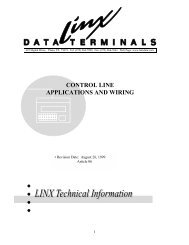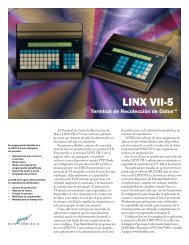Using the Linx 7-5 <strong>Data</strong> Collection TerminalThe Linx 7-5 <strong>Data</strong> Collection Terminal is a programmable device, which gives it theability to adapt to a rather wide variety of uses. But since not all uses requiresophisticated (and complex) programming methods, Linx provides a variety of waysto control the DCT, ranging from complex methods that grant complete control butrequire considerable programming training, to much simpler methods that do notoffer as much functionality (although still quite a bit) but require little or no suchtraining.Linx provides a few small demo programs for all the methods that are discussed. Wecan also develop custom applications.From the Complex to the SimpleNative ModeThe most feature rich method of programming the Linx 7-5 DCT is what we call“native mode”. This is the most complex and expensive, but allows access to all ofthe terminal’s capabilities at high speed. There are comparatively few applications,such as high speed process control, where this mode will be required. The vastmajority of applications can comfortably use one of the simpler modes. Native modeis about what you might expect: it is essentially “C” programming using a crosscompilerto prepare programs that run directly under the control of the terminal’soperating system. In native mode, the terminal can operate autonomously, or it canoperate as a component in a network (including under the control of anothercomputer); the choice is up to you.The Linx7-5 can also support a single user defined task (application). Thisapplication must be created by the user or VAR, using a Motorola Coldfire ‘C’compiler. Currently, the Crossware Compiler is the only one supported. However,others will be validated in the future. <strong>LINX</strong> provides a "hook" for the user taskthrough ThreadX the real time operating system being utilized. Although <strong>LINX</strong> hasacquired source code and licenses for the stack, RTOS, and the compiler, the userand/or VAR will only require a user license for the compiler.<strong>LINX</strong> will provide a set of libraries for special I/O devices access.File access will occur through ‘C” API functions.TCP/IP stack socket function access will be included.Host Control ModeAlmost as feature rich as native mode is “HCL mode”. The major difference is thatthe controlling program runs on a host computer rather than on the terminal itself.Due to the delays that are associated with communications, this will almost alwayspreclude real-time applications, but otherwise grants a very high degree of controlover the terminal. The major drawback of Host Control Mode is that the terminal isnot autonomous; if the host becomes unavailable, the terminal becomes nonfunctional.Like Native mode, experience at programming should be consideredrequired.For the Windows host environment, Linx supplies several .NET based componentsthat allow rapid development of host applications. Sorry, no such tools currentlyexist for non-Windows environments, but we do supply the necessary reference4 • Preface <strong>LINX</strong> 7-5 <strong>User's</strong> <strong>Guide</strong>
materials. For an easier method of implementation, see the next mode: the LinxAutomator.Linx Automator ModeNote: Automator requires.NET 1.1 or higher.<strong>LINX</strong> Automator is a .NET class library intended to allow the development ofWindows based applications that can control one or more <strong>LINX</strong> VII-5 <strong>Data</strong>Collection <strong>Terminals</strong>. Although it bears a slight relationship to LinxScript, there isone huge difference: <strong>LINX</strong> Automator runs on a host, whereas LinxScript runs onthe terminal.<strong>LINX</strong> Automator is a companion to <strong>LINX</strong> HCL.NET, which is also a Windowsbased class library that can be used to control terminals. Either can be used todevelop host based terminal control applications, but they are significantly differentin underlying philosophy. HCL.NET can be thought of as the counterpart to “nativemode” programming on the terminals, whereas <strong>LINX</strong> Automator can be thought ofas the counterpart to LinxScript. HCL.NET grants more complete control of theterminal, but at the cost of greater complexity. Automator is simpler, but does notoffer the fine detail of control. For the majority of applications, we anticipate theAutomator will be the methodology of choice. Users needing to exercise the greaterdegree of control offered by HCL.NET should be prepared for a lengthier and morecomplex development cycle.Since Automator is a .NET class library, at least some knowledge of working with.NET is considered required. The user application can be written in either VB.NET,C#, or Managed C++. The demonstration application, a rather minimal one, iswritten in C#. It might be possible to develop applications in ASP.NET, but this wasnot a design criteria and no attempt to test the feasability of this approach has beenmade.Scripted ModeThis is the middle of the road; our own fairly simple programming language,LinxScript, that runs right on the terminal. LinxScript offers nearly complete controlof the terminal but without the complexities of either native or host controlledmodes.No particular type of host or other specialized tools are required; all you need is anFTP client and a text editor. Programming experience is helpful but not required;experienced programmers can usually start developing LinxScript almost right out ofthe box, and even non-programmers can usually develop and deploy modestapplications in a fairly short time.When using LinxScript, the terminal is typically autonomous; no host connection isrequired, although it is allowed. <strong>Data</strong> collected by the terminal can be retrievedeither via FTP, or via our “HostQueue” mechanism. The latter is our own protocolthat allows data to be collected from the terminal very quickly (usually almost realtime)while still allowing the terminal to operate (and data to be preserved) when thehost is not available. Linx supplies a Windows based application, “Evolution”, thatcan manage a network of such terminals. For the non-Windows environment, theappropriate reference material is available. HostQueue is a subset of the HostControl Mode mentioned earlier, but does not require a constant connection betweenthe host and the terminal.LinxScript does offer a limited ability for the application to perform arithmetic andto control “files” residing on the terminal. LinxScript also provides a limited abilityto operate in a cooperative manner with other computers. This ability is currentlyonly provided via the terminal’s serial ports, but Telnet capability is currently beingdeveloped and other mechanisms may be available in the future. LinxScript can also<strong>LINX</strong> 7-5 <strong>User's</strong> <strong>Guide</strong> Preface • 5


